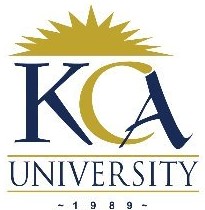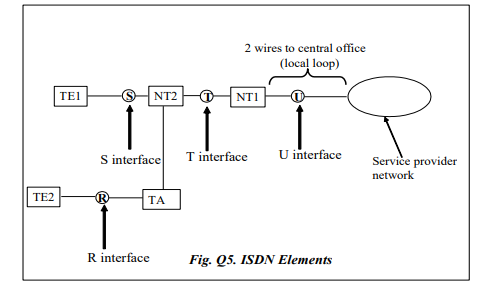 UNIVERSITY EXAMINATIONS: 2013/2014
UNIVERSITY EXAMINATIONS: 2013/2014
ORDINARY EXAMINATION FOR THE BACHELOR OF SCIENCE
IN INFORMATION TECHNOLOGY
BIT 4302 TELECOMMUNICATIONS DISTANCE LEARNING
DATE: AUGUST, 2014 TIME: 2 HOURS
INSTRUCTIONS: Answer Question ONE and any other TWO
QUESTION ONE
a) Define the following terminologies as used in telecommunications:
(i) Transmitter (1 Mark)
(ii) Circuit (1 Mark)
(iii) Full duplex (1 Mark)
(iv) Downlink (1 Mark)
(v) Noise (1 Mark)
b) With the aid of a diagram, explain the basic communication model. (5 Marks)
c) Describe briefly the role of the following bodies in telecommunications:
(i) ITU-R (2 Marks)
(ii) ITU-D (2 Marks)
d) Describe the following types of noise:
(i) Thermal noise (2 Marks)
(ii) Impulse Noise (2 Marks)
e) The Spectrum of a channel operates between 3 MHz and 4 MHz ; SNRdB = 24 dB.
Calculate its channel capacity. (6 Marks)
f) With any communications medium, the received signal will differ from the
transmitted signal due to various transmission impairments. Describe the
following transmission impairments:
(i) Attenuation distortion. (2 Marks)
(ii) Delay distortion (2 Marks)
(iii) Noise (2 Marks)
QUESTION TWO
a) The switching network could be packet switched or circuit switched. Briefly
highlight the features of each type of switching network. (6 Marks)
b) Describe the following physical WAN connections:
(i) Customer Premises Equipment (CPE) (2 Marks)
(ii) Data Communications Equipment (DCE) (2 Marks)
(iii) Demarcation Point (2 Marks)
(iv) Local Loop (2 Marks)
c) WANs use numerous types of devices that are specific to WAN environments.
Describe the following WAN devices:
(i) Modem (3 Marks)
(ii) CSU/DSU (3 Marks)
QUESTION THREE
a) Discuss the importance of segmenting messages before transmission. (5 Marks)
b) Networks rely on intermediary devices to provide connectivity and to work
behind the scenes to ensure that data flows across the network. These devices
connect the individual hosts to the network and can connect multiple individual
networks to form an internetwork. State five functions performed by processes
running on intermediary devices. ( 5 Marks)
c) The TCP/IP model describes the functionality of the protocols that make up the
TCP/IP protocol suite. These protocols, which are implemented on both the
sending and receiving hosts, interact to provide end-to-end delivery of
applications over a network. Describe the steps involved in a complete
communication process. (7 Marks)
d) Describe briefly the three standard methods used to connect your computer to
GPRS mobile phone. (3 Marks)
QUESTION FOUR
a) Because the amount of frequency spectrum available for mobile cellular use was
limited, efficient use of the required frequencies was needed for mobile cellular
coverage. In modern cellular telephony, rural and urban regions are divided into
areas according to specific provisioning guidelines. Deployment parameters, such
as amount of cell-splitting and cell sizes, are determined by engineers experienced
in cellular system architecture. Provisioning for each region is planned according
to an engineering plan that includes
cells,
clusters,
frequency reuse, and
handovers
Discuss briefly each of these concepts. (10 Marks)
b) The Fig below shows a typical ISDN setup.
(i) Explain the terms: TE1, TE2, TA, NT1 and NT2. (5 Marks)
(ii) State TWO disadvantages of ISDN as a WAN design solution.
(2 Marks)
(iii) State THREE benefits of bringing digital connectivity through ISDN to
the local site. (3 Marks)

QUESTION FIVE
a) Communication between individuals is determined to be successful when the
meaning of the message understood by the recipient matches the meaning
intended by the sender. State five external factors that affect the success of
communication. (5 Marks)
b) IEEE 802.11 is the standard that specifies connectivity for wireless networks.
IEEE 802.11, or Wi-Fi, refers to a collective group of standards. These protocols
specify the frequencies, speeds, and other capabilities of the different Wi-Fi
standards. In this regard, describe the following standards:
(i) IEEE 802.11a (2 Marks)
(ii) IEEE 802.11b (2 Marks)
(iii) IEEE 802.11g (2 Marks)
c) Telecommunications facilities in the world are systematically being upgraded
from analog to digital facilities. Discuss the reasons behind this very significant
movement. (5 Marks)
d) State four major differences between WLANs and wired Ethernet. (4 Marks)
